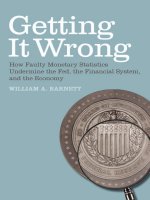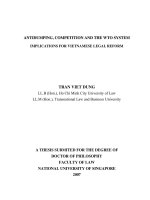Saving, Investment, and the Financial System
Bạn đang xem bản rút gọn của tài liệu. Xem và tải ngay bản đầy đủ của tài liệu tại đây (399.09 KB, 19 trang )
Saving, Investment,
and the Financial
System
Chapter 26
Copyright © 2001 by Harcourt, Inc.
All rights reserved. Requests for permission to make copies of any part of the
work should be mailed to:
Permissions Department, Harcourt College Publishers,
6277 Sea Harbor Drive, Orlando, Florida 32887-6777.
The Financial System
◆
◆
◆
The financial system consists of institutions
that help to match one person’s saving with
another person’s investment.
It moves the economy’s scarce resources
from savers to borrowers.
The financial system is made up of
institutions(Markets and Intermediaries)
Harcourt, Inc. items and derived items copyright © 2001 by Harcourt, Inc.
Financial Institutions
in the U.S. Economy
◆
Financial Markets
Stock Market
◆ Bond Market
◆
◆
Financial Intermediaries
Banks
◆ Mutual Funds
◆
Harcourt, Inc. items and derived items copyright © 2001 by Harcourt, Inc.
Other Financial Institutions
◆ Credit
unions
◆ Pension funds
◆ Insurance companies
◆ Loan sharks
Harcourt, Inc. items and derived items copyright © 2001 by Harcourt, Inc.
The Bond Market
A bond is a certificate
of indebtedness that
specifies obligations of
the borrower to the
holder of the bond.
IOU
Harcourt, Inc. items and derived items copyright © 2001 by Harcourt, Inc.
Characteristics of a Bond
◆
◆
◆
Term: The length of time until the bond
matures.
Credit Risk: The probability that the
borrower will fail to pay some of the interest
or principal.
Tax Treatment: The way in which the tax
laws treat the interest on the bond.
◆
Municipal bonds are federal tax exempt.
Harcourt, Inc. items and derived items copyright © 2001 by Harcourt, Inc.
Stock Market Basics
◆
What is Stock?
➤A stock is a
tradable security
that a firm issues to
certify that the
stockholder owns a
share of the firm.
➤Figure 19.1 shows
an example of a
stock certificate.
Harcourt, Inc. items and derived items copyright © 2001 by Harcourt, Inc.
The Stock Market
◆
◆
Stock represents ownership in a firm and is
therefore, a claim to the profits that the firm
makes.
The sale of stock to raise money is called
equity financing.
◆
Compared to bonds, stocks offer both higher
risk and potentially higher returns.
Harcourt, Inc. items and derived items copyright © 2001 by Harcourt, Inc.
The Stock Market
The most important stock exchanges in
the United States are the New York
Stock Exchange, the American Stock
Exchange, and NASDAQ.
Harcourt, Inc. items and derived items copyright © 2001 by Harcourt, Inc.
The Stock Market
Most newspaper stock tables provide the
following information:
◆ Price (of a share)
◆ Volume (number of shares sold)
◆ Dividend (profits paid to stockholders)
◆ Price-earnings ratio
Harcourt, Inc. items and derived items copyright © 2001 by Harcourt, Inc.
Stock Market Basics
◆
Reading the Stock Market Report
➤Figure 19.2 in the textbook shows a part of a page
from of the Wall Street Journal.
Harcourt, Inc. items and derived items copyright © 2001 by Harcourt, Inc.
The Market for Loanable Funds
Loanable funds refers to all income
that people have chosen to save and
lend out, rather than use for their
own consumption.
Harcourt, Inc. items and derived items copyright © 2001 by Harcourt, Inc.
Market for Loanable Funds...
Interest
Rate
Supply
5%
Demand
0
$1,200
Harcourt, Inc. items and derived items copyright © 2001 by Harcourt, Inc.
Loanable Funds (in
billions of dollars)
Government Policies That Affect
Saving and Investment
◆ Taxes
and saving
◆ Taxes and investment
◆ Government budget deficits
Harcourt, Inc. items and derived items copyright © 2001 by Harcourt, Inc.
Harcourt, Inc. items and derived items copyright © 2001 by Harcourt, Inc.
An Increase in the Supply of Loanable
Funds...
Interest
Rate
Supply, S1
S2
1. Tax incentives for
saving increase the
supply of loanable
funds...
5
%
4%
Demand
2. ...which
reduces the
equilibrium
interest rate...
0
$1,200
Loanable Funds
$1,600
(in billions of dollars)
3. ...and raises the equilibrium quantity of loanable funds.
Harcourt, Inc. items and derived items copyright © 2001 by Harcourt, Inc.
An Increase in the Demand for
Loanable Funds...
Interest
Rate
6%
5%
2. ...which
raises the
equilibrium
interest rate...
0
Supply
1. An investment tax
credit increases the
demand for loanable
funds...
D2
Demand, D1
$1,400
$1,200
Loanable Funds
(in billions of dollars)
3. ...and raises the equilibrium
quantity of loanable funds.
Government Budget Deficits and
Surpluses
◆
When the government spends more than it
receives in tax revenues, the short fall is called
the budget deficit.
➤
◆
For 2003, the budget deficit is $307 billion
The accumulation of past budget deficits is called
the government debt.
➤
For 2003, the total debt is 6.7 trillion.
Harcourt, Inc. items and derived items copyright © 2001 by Harcourt, Inc.
Government Budget Deficits and
Surpluses
Government borrowing to finance its
budget deficit reduces the supply of
loanable funds available to finance
investment by households and firms.
◆ This fall in investment is referred to as
crowding out.
◆
◆
The deficit borrowing crowds out private
borrowers who are trying to finance
investments.
Harcourt, Inc. items and derived items copyright © 2001 by Harcourt, Inc.
Harcourt, Inc. items and derived items copyright © 2001 by Harcourt, Inc.
The Effect of a Government Budget
Deficit...
Interest
Rate
S2
6%
5%
2. ...which
raises the
equilibrium
interest rate...
$800
$1,200
0
3. ...and reduces the equilibrium
quantity of loanable funds.
Supply, S1
1. A budget deficit
decreases the
supply of loanable
funds...
Demand
Loanable Funds
(in billions of dollars)









